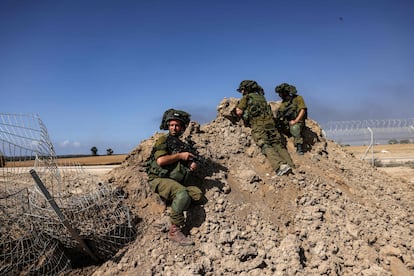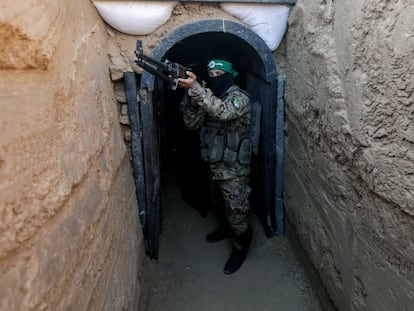Israel outlines three-phase plan to overthrow Hamas in Gaza
Defense Minister Yoav Gallant explains the stages of his country’s political and military plans in the Strip. Bombardments and the imminent ground incursion are the first step

After 13 days of massive aerial bombardment and on the verge of launching a ground invasion, Israeli Defense Minister Yoav Gallant on Friday provided the most detailed explanation of his country’s political and military plans in Gaza. It is a three-phase plan, which would conclude with “the establishment of a new security reality for the citizens of Israel,” without deploying soldiers permanently in the Gaza Strip to manage the day-to-day life of its 2.3 million inhabitants. In 2005, the government of then Prime Minister Ariel Sharon evacuated the 8,000 settlers and military it had in Gaza, which it had captured from Egypt in the 1967 Six-Day War.
Israel, Gallant explained, is now in the first phase: “a military campaign that includes bombing and later will include [ground] maneuvers, with the aim of neutralizing terrorists and destroying Hamas infrastructure.” Military aircraft are bombing the Strip “at a pace not seen in decades” to “prepare the ground” for the ground invasion and are making small raids in order to “get information about hostages” held in the Strip, army spokesman Daniel Hagari said Friday in his daily media appearance in Tel Aviv. The attacks have killed 4,137 people and wounded more than 13,000, according to figures provided Friday by the Health Ministry in Gaza. Gallant assured troops deployed on the border Thursday that “soon” they will see Gaza “from the inside.”
The second phase “will require operations of lesser intensity, with the aim of eliminating pockets of resistance,” Gallant said at a meeting at the Defense Ministry headquarters in Tel Aviv with members of the Foreign Affairs and Defense Committee of the Israeli Parliament. In other words, keeping troops on the ground to put an end to the insurgency, which is expected to act in a less organized manner.
“In the end, at some point, we will reach a situation where there will be a different security authority, that we have full operational freedom and there is no threat inside Gaza. It won’t be [in] one day, or one week, or, to my regret, one month. You have to understand that, but that’s the process,” he said.

The final phase would consist of the “withdrawal of Israel’s responsibility for life in the Gaza Strip and the establishment of a new security reality for the citizens of Israel.” Gallant did not explain to whom the management of the administration of the Strip would be transferred, once the Hamas government is overthrown.
Technically, Israel continues to have responsibility for the population of Gaza. The territory did not cease to be considered under military occupation after the 2005 withdrawal, because Israel maintains control of its air and sea space. Israel argues that this is not the case because it no longer has troops or settlers on the ground and because all of Gaza is Area A, i.e., that which remains under the administrative and security control of the Palestinian Authority (PNA), in accordance with the Oslo Accords signed in 1993. Since 2007, the PNA has had no control over Gaza after Hamas seized power there by expelling forces loyal to the rival Fatah faction. A year earlier, the Islamist movement had won elections, but the international community did not recognize the new government because it refused to recognize Israel and explicitly renounce violence.
Reserve Commander General Gadi Shamni, former head of the Gaza Division and former military attaché in the United States, estimated this week that the entire operation will take between six and eight months. “Conquering Gaza, taking control of it will be a few weeks,” he told Channel 12 national television. Then the mission will consist of killing and capturing all Hamas militiamen. Shamni proposed “imprisoning thousands” of them in the Negev desert “to serve as a bargaining tool” in exchange for the more than 200 hostages in the Strip.
Two of them were the first to be released on Friday, according to Abu Obeida, the spokesman for the Izz ad-Din al-Qassam Brigades (the armed wing of Hamas), and confirmed by the Israeli Prime Minister’s office. Abu Obeida justified the decision on “humanitarian grounds” and to “prove to the American people and the world that the claims of [U.S. President Joe] Biden and his fascist government are false and baseless.” During his whirlwind visit to Israel last Wednesday, the U.S. leader accused Hamas of having committed “atrocities that make ISIS [Islamic State] look somewhat more rational” by killing 1,400 people and kidnapping more than 200 in a massive surprise raid in Israel on October 7.
Israeli official sources have identified the freed women as Judith Raanan and her daughter Natalie. They reside in Illinois (U.S.) and had flown to Israel to celebrate Judith’s mother’s 85th birthday and Jewish holidays. They were at a kibbutz near Gaza — Nahal Oz — at the time of the attack, which was deliberately launched on the last day of the Sukkot holiday. The Israeli organization representing the families of the missing and kidnapped has welcomed the news and called on the leaders of Arab countries to act for the “immediate release” of the rest. Consulted by this newspaper, the International Committee of the Red Cross has not confirmed it.
Sign up for our weekly newsletter to get more English-language news coverage from EL PAÍS USA Edition
Tu suscripción se está usando en otro dispositivo
¿Quieres añadir otro usuario a tu suscripción?
Si continúas leyendo en este dispositivo, no se podrá leer en el otro.
FlechaTu suscripción se está usando en otro dispositivo y solo puedes acceder a EL PAÍS desde un dispositivo a la vez.
Si quieres compartir tu cuenta, cambia tu suscripción a la modalidad Premium, así podrás añadir otro usuario. Cada uno accederá con su propia cuenta de email, lo que os permitirá personalizar vuestra experiencia en EL PAÍS.
¿Tienes una suscripción de empresa? Accede aquí para contratar más cuentas.
En el caso de no saber quién está usando tu cuenta, te recomendamos cambiar tu contraseña aquí.
Si decides continuar compartiendo tu cuenta, este mensaje se mostrará en tu dispositivo y en el de la otra persona que está usando tu cuenta de forma indefinida, afectando a tu experiencia de lectura. Puedes consultar aquí los términos y condiciones de la suscripción digital.
More information
Archived In
Últimas noticias
The complicated life of Francesca Albanese: A rising figure in Italy but barred from every bank by Trump’s sanctions
Reinhard Genzel, Nobel laureate in physics: ‘One-minute videos will never give you the truth’
Pinochet’s victims grapple with José Antonio Kast’s rise in Chile
Half of Scotland is in the hands of 420 property owners
Most viewed
- Pablo Escobar’s hippos: A serious environmental problem, 40 years on
- Reinhard Genzel, Nobel laureate in physics: ‘One-minute videos will never give you the truth’
- Why we lost the habit of sleeping in two segments and how that changed our sense of time
- Charles Dubouloz, mountaineering star, retires at 36 with a farewell tour inspired by Walter Bonatti
- The Florida Keys tourist paradise is besieged by immigration agents: ‘We’ve never seen anything like this’










































